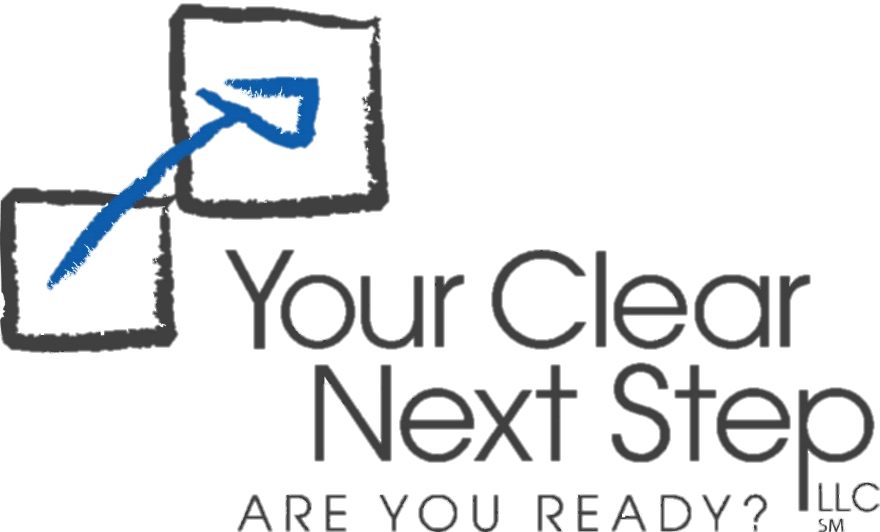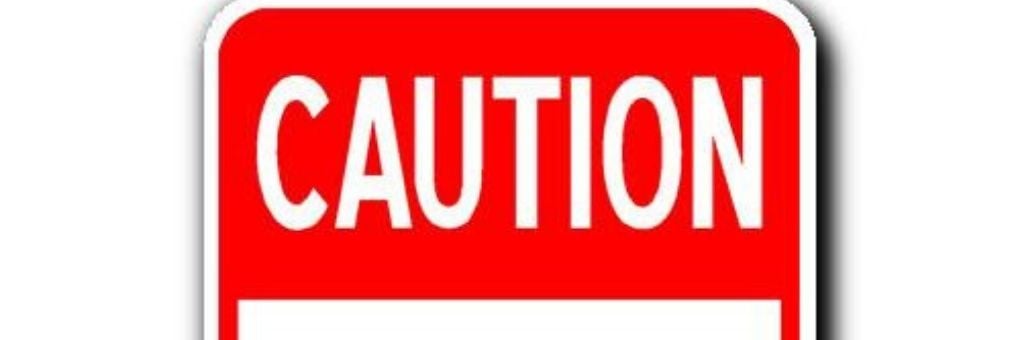Using Road Signs Within Our Organizations
Last week we talked about the road signs we might be interested in carrying around as individuals to help with the emotional intelligence of ourselves and those around us, ultimately improving interpersonal relations. That inspired me to go looking for some road signs that we could probably use at an organizational level.
While it may not be possible to actually hang road signs up in your company’s hallways, using the word picture of a road sign may help you create some messaging within your organization. Think of things companies have done over the years such as putting safety metrics on the wall, putting sales goals on bulletin boards or movable whiteboards, designating spaces as “war rooms” or “project team rooms.” Feel free to get as creative as your organization will allow!
With that, here are seven road signs we could probably use in our organizations.
1. “Work Zone”
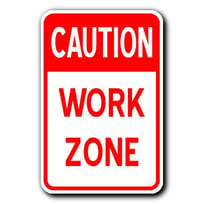 On the road, this sign is used to alert drivers that they are entering a work zone. When we see these signs, we know to expect to have to use extra caution while driving since there might be workers along the road.
On the road, this sign is used to alert drivers that they are entering a work zone. When we see these signs, we know to expect to have to use extra caution while driving since there might be workers along the road.
Within our organizations these signs could be used to alert others that we are mid-project, with a team of people working diligently to accomplish the work. Just like in a work zone on the road, we should use extra caution not to jeopardize the safety of any of the workers as there is a lot of heavy lifting going on. This sign also provides a good reminder to all of us that miracles don’t happen overnight. A ‘Work Zone’ sign can remind all of us that we are not to our end state yet. In the long run, we are going to progress past the single-lane gravel road that we started with, but it’s going to take time to become a four-lane divided highway. While we’re in this ‘Work Zone’ we should be cautious and sensitive with each other and patient with the imperfections.
2. “Expect Delays”
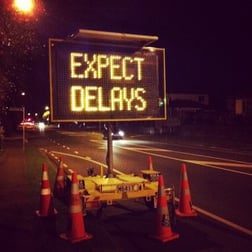 These signs are most often used in metropolitan areas to give drivers a heads up about how long it’s going to take to get from one exit to another, or how long it’s going to take to get through the heftiest portion of the rush hour traffic.
These signs are most often used in metropolitan areas to give drivers a heads up about how long it’s going to take to get from one exit to another, or how long it’s going to take to get through the heftiest portion of the rush hour traffic.
So, what if in our organizations we had a sign that said, ‘Be Prepared For Delays’ or ‘Expect Delays’ or even flashing lights that indicate how long it’s going to be until this project is finished and we are able to start on the next initiative. What if we had some way to indicate to others that there’s stuff going on that could cause the work we usually do to be less timely than usual?
IT teams often feel this demand when multiple business units are requesting changes or edits at the same time, and they might be well served with a sign that says, ‘Expect delays’ or ‘Traffic is heavy’ or ‘It’s X number of days between milestones in the request process’. Usually it’s smooth sailing, but during rush hour, or these peak seasons, it’s helpful to communicate to others about the expected delays. I think that would help improve the mood of the internal customers too – by expecting the delays, they can plan around them.
3. “Slow Down”
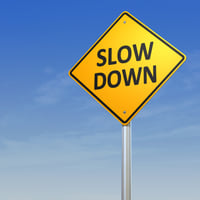 Just as it sounds, these signs tell us to reduce our speed behind the wheel. Often, we see them as we approach a sharp curve, a steep hill, or an area where we need to be more alert.
Just as it sounds, these signs tell us to reduce our speed behind the wheel. Often, we see them as we approach a sharp curve, a steep hill, or an area where we need to be more alert.
Often times in our organizations, we need to be reminded not to take on everything all at once. There was a statistic that came out a few years ago that indicated that many organizations could only afford to do about 60% of what they wanted to do. Even when we can only afford to do some portion of what we want to do, too many of us still try to accomplish all of the initiatives we want. We shouldn’t be surprised then, when we end up over-saturating our organizations and overextending our employees. What if we could just remind ourselves to slow down and stop taking everything on as if it’s the highest priority. A reminder to ‘Slow Down’, might also help prevent us from making careless mistakes in haste that we wouldn’t have made if we hadn’t been moving so quickly.
4. “Sharp Turn Ahead”
 You’ve likely seen these yellow diamond signs with a curved arrow on them, indicating that there is a sharp turn up ahead. These signs alert drivers that they should plan to reduce their speed and be prepared to change their direction. Where I-90 runs through Cleveland, for example, there are some pretty useful signs. I-90 varies in speed limits across state lines, and in Ohio, where it’s usually a 65-mph interstate, the speed limit slows down in cities. But in Cleveland, when you get to the heart of the city, the interstate curves at a 90-degree angle. Drivers have to slow to speeds of 35 mph as they go through Cleveland. And there’s sign after sign after sign saying, ‘slow down, sharp turn ahead’ or ‘be aware, sharp turn ahead’.
You’ve likely seen these yellow diamond signs with a curved arrow on them, indicating that there is a sharp turn up ahead. These signs alert drivers that they should plan to reduce their speed and be prepared to change their direction. Where I-90 runs through Cleveland, for example, there are some pretty useful signs. I-90 varies in speed limits across state lines, and in Ohio, where it’s usually a 65-mph interstate, the speed limit slows down in cities. But in Cleveland, when you get to the heart of the city, the interstate curves at a 90-degree angle. Drivers have to slow to speeds of 35 mph as they go through Cleveland. And there’s sign after sign after sign saying, ‘slow down, sharp turn ahead’ or ‘be aware, sharp turn ahead’.
Especially in a period of transition or change, “Sharp Turn Ahead” signs could be especially useful in our organizations. If we could somehow visually represent to our organization that this is not a minor curve, but rather a big change, we might be able to better handle to turn together.
5. “No U-Turn”
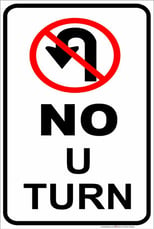 We tend to see these signs posted at intersections and just as it sounds, they tell us not to make a U-turn. Following on the line of thinking of transformation initiatives and changes, what if, after a significant change has begun in an organization, we could put up ‘no U-turn signs’? So many organizations have implemented cultural changes, paradigm shifts, or any other sort of ‘sharp turn’. Maybe we’ve gone from a focus on customer service to a focus on operational efficiency. Maybe we’ve gone from a period of optimization to a period of expansion and customer growth. Maybe we’ve gone from a period of growth to a period of stabilization or customer retention. But at some point, we’ve made a material shift in the way we look at things. We’ve gone to a paperless environment, or we’ve gone to an employee-centric workplace.
We tend to see these signs posted at intersections and just as it sounds, they tell us not to make a U-turn. Following on the line of thinking of transformation initiatives and changes, what if, after a significant change has begun in an organization, we could put up ‘no U-turn signs’? So many organizations have implemented cultural changes, paradigm shifts, or any other sort of ‘sharp turn’. Maybe we’ve gone from a focus on customer service to a focus on operational efficiency. Maybe we’ve gone from a period of optimization to a period of expansion and customer growth. Maybe we’ve gone from a period of growth to a period of stabilization or customer retention. But at some point, we’ve made a material shift in the way we look at things. We’ve gone to a paperless environment, or we’ve gone to an employee-centric workplace.
What if we could put ‘no U-turn’ signs on the walls during the implementation of these material shifts? Something that says, ‘no going back’. That is not to discredit or discount where we’ve been because we wouldn’t be where we are today if not for the growth of the past, but we are in a new place now and we should not go back.
6. “Stay In Your Lane”
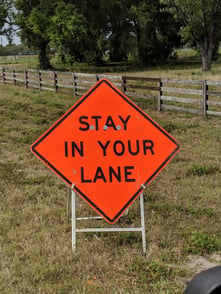 Much as it sounds, these signs tell us to stick with the lane that we are in. These signs are sometimes posted at blind corners or heavily congested areas, where changing lanes could be especially dangerous.
Much as it sounds, these signs tell us to stick with the lane that we are in. These signs are sometimes posted at blind corners or heavily congested areas, where changing lanes could be especially dangerous.
I know some organizations would like to have this sign posted throughout the office, and I see the benefits. I am not advocating for siloed behavior, where we’re not aware of or connected with each other. But, especially in moments of transition or busy periods, it’s really important that each one of us stays focused on the work that we have been assigned to do. If I stop paying attention to my own lane and my own work, and I instead become a curious onlooker to something else and I slow down or veer into another lane, I have the potential to cause all kinds of damage. In those highly sensitive moments where we clearly define roles and responsibilities, and we clearly define roles about decision making and prioritization, what if we could then use a ‘stay in your lane’ message – not to mean ‘I don’t want to hear from you or your perspectives’ but to say ‘Hey, I need you to watch your area of focus right now because we need each person paying attention to what they are doing themselves, and not getting distracted by what’s going on in other lanes’. Know your own responsibilities and focus on executing them exceptionally well during times of transition.
7. “Do Not Enter”
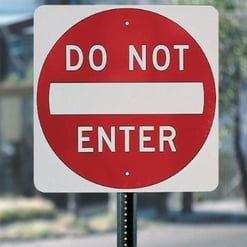 This last sign is just as it sounds. We often see these at entrance to highways or driveways and they tell us where not to go. In thinking about these in an organizational context, I’m not saying we should put this up outside of our offices and keep out customers, vendor partners, or potential employees. As much as many of us would love to have a few moments of uninterrupted desk-time in our days to get work done, that’s not at all what I mean here!
This last sign is just as it sounds. We often see these at entrance to highways or driveways and they tell us where not to go. In thinking about these in an organizational context, I’m not saying we should put this up outside of our offices and keep out customers, vendor partners, or potential employees. As much as many of us would love to have a few moments of uninterrupted desk-time in our days to get work done, that’s not at all what I mean here!
Instead, I’m thinking of ‘do not enter’ as a sign that would protect us against bad decisions. This sign could somehow be used in an organization to say, Do Not Enter ‘any path that is not consistent with who we are or the mission we stand for’ or, ‘any road that will not result in the outcomes we are hoping for. I imagine this could be supplied by someone who has a special assignment to benchmark similar projects or initiatives with other organizations. Alternatively, perhaps there’s a watchdog group keeping track of our organizational values and how we live those out. But I think it could be useful if someone somewhere were equipped with a sign to warn us as a team not to enter down the unproductive paths.
There you have it. Seven road signs you might be able to use in your organization. Know of any others? Join us on social media!
